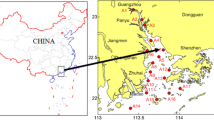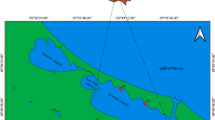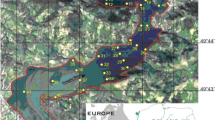Abstract
Historical distribution characteristics of polycyclic aromatic hydrocarbons (PAHs) and their carriers (i.e., organic matter and mineral particles) in the sediment cores of the Yangtze Estuary were investigated, with emphasis laid on the role of the Yangtze River. Grain size component of sediments (clay, silt, and sand) and organic carbon (black carbon and total organic carbon) in the sediment cores were markedly affected by water flux and sediment discharge of the Yangtze River. Qualitative and quantitative analysis results showed that sands and black carbon acted as the main carriers of PAHs. The sedimentation of two-ring to three-ring PAHs in the estuary had significant correlations with water flux and sediment discharge of the Yangtze River. The relative lower level of the four-ring and five-ring to six-ring PAHs concentrations appeared around the year 2003 and remained for the following several years. This time period accorded well with the water impoundment time of the Three Gorges Reservoir. The decreased level of two-ring to three-ring PAHs occurred in the year 1994, and the peak points around the year 2009 indicated that PAHs sedimentation in the estuary also had close relationship to severe drought and flood in the catchments. The findings presented in this paper could provide references for assessing the impacts of water flux and sediment discharge on the historical deposition of PAHs and their carriers in the Yangtze Estuary.




Similar content being viewed by others
References
Adeleye, A. O., Jin, H., Di, Y., Li, D., Chen, J., & Ye, Y. (2016). Distribution and ecological risk of organic pollutants in the sediments and seafood of Yangtze Estuary and Hangzhou Bay, East China Sea. Science of the Total Environment, 541, 1540–1548.
Bouloubassi, I., Roussiez, V., Azzoug, M., & Lorre, A. (2012). Sources, dispersal pathways and mass budget of sedimentary polycyclic aromatic hydrocarbons (PAHs) in the NW Mediterranean margin, Gulf of Lions. Marine Chemistry, 142-144(11), 18–28.
Brandli, R. C., Hartnik, T., Henriksen, T., & Cornelissen, G. (2008). Sorption of native polyaromatic hydrocarbons (PAHs) to black carbon and amended activated carbon in soil. Chemosphere, 73(11), 1805–1810.
Chen, Z., Saito, Y., Kanai, Y., Wei, T., Li, L., Yao, H., & Wang, Z. (2004). Low concentration of heavy metals in the Yangtze estuarine sediments, China: a diluting setting. Estuarine, Coastal and Shelf Science, 60(1), 91–100.
Chen, J., Finlayson, B. L., Wei, T. Y., Sun, Q. L., Webber, M., Li, M. T., & Chen, Z. Y. (2016). Changes in monthly flows in the Yangtze River, China—with special reference to the Three Gorges Dam. Journal of Hydrology, 536, 293–301.
Dai, S. B., Lu, X. X., Yang, S. L., & Cai, A. M. (2008). A preliminary estimate of human and natural contributions to the decline in sediment flux from the Yangtze River to the East China Sea. Quaternary International, 186(1), 43–54.
Dong, J. W., Xia, X. H., Wang, M. H., Lai, Y. J., Zhao, P. J., Dong, H. Y., Zhao, Y. L., & Wen, J. J. (2015). Effect of water–sediment regulation of the Xiaolangdi Reservoir on the concentrations, bioavailability, and fluxes of PAHs in the middle and lower reaches of the Yellow River. Journal of Hydrology, 527, 101–112.
Doong, R., & Lin, Y. (2004). Characterization and distribution of polycyclic aromatic hydrocarbon contaminations in surface sediment and water from Gao-Ping River, Taiwan. Water Research, 38(7), 1733–1744.
Feng, J. L., Yang, Z. F., Niu, J. F., & Shen, Z. Y. (2007). Remobilization of polycyclic aromatic hydrocarbons during the resuspension of Yangtze River sediments using a particle entrainment simulator. Environmental Pollution, 149(2), 193–200.
Feng, C. H., Zhao, S., Wang, D. X., Niu, J. F., & Shen, Z. Y. (2014). Sedimentary records of metal speciation in the Yangtze Estuary: role of hydrological events. Chemosphere, 107, 415–422.
Flynn, W. W. (1968). The determination of low levels of polonium-210 in environmental materials. Analytica Chimica Acta, 43(2), 221–227.
Gao, S. H., Chen, J., Shen, Z. Y., Liu, H., & Chen, Y. X. (2013). Seasonal and spatial distributions and possible sources of polychlorinated biphenyls in surface sediments of Yangtze Estuary, China. Chemosphere, 91(6), 809–816.
Ghosh, U., Gillette, J. S., Luthy, R. G., & Zare, R. N. (2000). Microscale location, characterization, and association of polycyclic aromatic hydrocarbons on harbor sediment particles. Environmental Science & Technology, 34(9), 1729–1736.
Giuliani, S., Piazza, R., Moumni, B. E., Polo, F. P., Vecchiato, M., Romano, S., et al. (2015). Recognizing different impacts of human and natural sources on the spatial distribution and temporal trends of PAHs and PCBs (including PCB-11) in sediments of the Nador Lagoon (Morocco). Science of the Total Environment, 526, 346–357.
Guo, Z. G., Lin, T., Zhang, G., Yang, Z. S., & Fang, M. (2006). High-resolution depositional records of polycyclic aromatic hydrocarbons in the central continental shelf mud of the East China Sea. Environmental Science & Technology, 40(17), 5304–5311.
Hoffmann, T., Thorndycraft, V. R., Brown, A. G., Coulthard, T. J., Damnati, B., Kale, V. S., Middelkoop, H., Notebaert, B., & Walling, D. E. (2010). Human impact on fluvial regimes and sediment flux during the Holocene: review and future research agenda. Global and Planetary Change, 72(3), 87–98.
Huang, W. X., Wang, Z. Y., & Yan, W. (2012). Distribution and sources of polycyclic aromatic hydrocarbons (PAHs) in sediments from Zhanjiang Bay and Leizhou Bay, South China. Marine Pollution Bulletin, 64(9), 1962–1969.
Jiang, L. Z., Ban, X., Wang, X. L., & Cai, X. B. (2014). Assessment of hydrologic alterations caused by the Three Gorges Dam in the middle and lower reaches of Yangtze River, China. Water, 6(5), 1419–1434.
Li, H. L., Hong, G., Chen, Z., Li, G. G., Fan, Y., Gong, Z. Y., et al. (2009). Spatial and temporal distribution of polycyclic aromatic hydrocarbons (PAHs) in sediments of the Nansi Lake, China. Environmental Monitoring & Assessment, 154(1–4), 469–478.
Li, Q. F., Yu, M. X., Lu, G. B., Cai, T., Bai, X., & Xia, Z. Q. (2011). Impacts of the Gezhouba and Three Gorges reservoirs on the sediment regime in the Yangtze River, China. Journal of Hydrology, 403(3–4), 224–233.
Li, B. H., Feng, C. H., Li, X., Chen, Y. X., Niu, J. F., & Shen, Z. Y. (2012). Spatial distribution and source apportionment of PAHs in surficial sediments of the Yangtze Estuary, China. Marine Pollution Bulletin, 64(3), 636–643.
Li, P., Rui, X., Wang, Y., Zhang, R., & Gan, Z. (2015). Influence of anthropogenic activities on PAHs in sediments in a significant gulf of low-latitude developing regions, the Beibu Gulf, South China Sea: distribution, sources, inventory and probability risk. Marine Pollution Bulletin, 90(1–2), 218–226.
Liang, Y., Tse, M. F., Young, L., & Wong, M. H. (2007). Distribution patterns of polycyclic aromatic hydrocarbons (PAHs) in the sediments and fish at Mai Po Marshes Nature Reserve, Hong Kong. Water Research, 41(6), 1303–1311.
Liu, M., Baugh, P. J., Hutchinson, S. M., Yu, L., & Xu, S. (2000). Historical record and sources of polycyclic aromatic hydrocarbons in sediment cores from the Yangtze Estuary, China. Environmental Pollution, 110(2), 357–365.
Liu, G. Q., Zhang, G., Li, X. D., Li, J., Peng, X. Z., & Qi, S. H. (2005). Sedimentary record of polycyclic aromatic hydrocarbons in a sediment core from the Pearl River Estuary, South China. Marine Pollution Bulletin, 51(s 8–12), 912–921.
Lohmann, R., MacFarlane, J. K., & Gschwend, P. M. (2005). Importance of black carbon to sorption of native PAHs, PCBs, and PCDDs in Boston and New York harbor sediments. Environmental Science & Technology, 39(1), 141–148.
Machado, K. S., Figueira, R. C., Côcco, L. C., Froehner, S., Fernandes, C. V., & Ferreira, P. A. (2014). Sedimentary record of PAHs in the Barigui River and its relation to the socioeconomic development of Curitiba, Brazil. Science of the Total Environment, 482-483(2), 42–52.
Men, B., He, M. C., Tan, L., Lin, C. Y., & Quan, X. C. (2009). Distribution of polycyclic aromatic hydrocarbons in the Daliao River Estuary of Liaodong Bay, Bohai Sea (China). Marine Pollution Bulletin, 58(6), 818–826.
Milliman, J. D., Xie, Q. C., & Yang, Z. S. (1984). Transfer of particulate organic carbon and nitrogen from the Yangtze River to the ocean. American Journal of Science, 284(7), 824–834.
Milliman, J. D., Beardsley, R. C., Yang, Z. S., & Limeburner, R. (1985). Modern Huanghe-derived muds on the outer shelf of the East China Sea: identification and potential transport mechanisms. Continental Shelf Research, 85(4), 175–188.
Prahl, F. G., & Carpenter, R. (1983). Polycyclic aromatic hydrocarbon (PAH)-phase associations in Washington coastal sediment. Geochimica et Cosmochimica Acta, 47(6), 1013–1023.
Rachdawong, P., Christensen, E. R., & Karls, J. F. (1998). Historical PAH fluxes to Lake Michigan sediments determined by factor analysis. Water Research, 32(8), 2422–2430.
Ren, C., Wu, Y., Zhang, S., Wu, L. L., Liang, X. G., Chen, T. H., et al. (2015). PAHs in sediment cores at main river estuaries of Chaohu Lake: implication for the change of local anthropogenic activities. Environmental Science & Pollution Research, 22(3), 1687–1696.
Rockne, K. J., Shor, L. M., Young, L. Y., Taghon, G. L., & Kosson, D. S. (2002). Distributed sequestration and release of PAHs in weathered sediment: the role of sediment structure and organic carbon properties. Environmental Science & Technology, 36(12), 2636–2644.
Simpson, C. D., Mosi, A. A., Cullen, W. R., & Reimer, K. J. (1996). Composition and distribution of polycyclic aromatic hydrocarbons in surficial marine sediments from Kitimat Harbour, Canada. Science of the Total Environment, 181(3), 265–278.
Simpson, C. D., Harrington, C. F., Cullen, W. R., Bright, D. A., & Reimer, K. J. (1998). Polycyclic aromatic hydrocarbon contamination in marine sediments near Kitimat, British Columbia. Environmental Science & Technology, 32(21), 3266–3272.
Singh, K. P., Mohan, D., Singh, V. K., & Malik, A. (2005). Studies on distribution and fractionation of heavy metals in Gomti river sediments-tributary of the Ganges, India. Journal of Hydrology, 312(1–4), 14–27.
Sun, Z., Huang, Q., Opp, C., Hennig, T., & Marold, U. (2012). Impacts and implications of major changes caused by the Three Gorges Dam in the middle reaches of the Yangtze River, China. Water Resources Management, 26(12), 3367–3378.
Varnosfaderany, M. N., Bakhtiari, A. R., Gu, Z., & Chu, G. (2014). Vertical distribution and source identification of polycyclic aromatic hydrocarbons (PAHs) in southwest of the Caspian Sea: most petrogenic events during the late little ice age. Marine Pollution Bulletin, 87(1–2), 152–163.
Viguri, J., Verde, J., & Irabien, A. (2002). Environmental assessment of polycyclic aromatic hydrocarbons (PAHs) in surface sediments of the Santander Bay, Northern Spain. Chemosphere, 48(2), 157–165.
Wang, X., & Li, Y. (2011). Measurement of Cu and Zn adsorption onto surficial sediment components: new evidence for less importance of clay minerals. Journal of Hazardous Materials, 189(3), 719–723.
Wang, L. L., Niu, J. F., Yang, Z. F., Shen, Z. Y., & Wang, J. Y. (2008). Effects of carbonate and organic matter on sorption and desorption behavior of polycyclic aromatic hydrocarbons in the sediments from Yangtze River. Journal of Hazardous Materials, 154(1), 811–817.
Wang, D. X., Feng, C. H., Huang, L. X., Niu, J. F., & Shen, Z. Y. (2013). Historical deposition behaviors of PAHs in the Yangtze River Estuary: role of the sources and water currents. Chemosphere, 90(6), 2020–2026.
Wang, S., Wang, Y., Ran, L., & Su, T. (2015). Climatic and anthropogenic impacts on runoff changes in the Songhua River basin over the last 56 years (1955-2010), Northeastern China. Catena, 127, 258–269.
Wu, Y., Bao, H., Yu, H., Zhang, J., & Kattner, G. (2015). Temporal variability of particulate organic carbon in the lower Changjiang (Yangtze River) in the post Three Gorges Dam period: links to anthropogenic and climate impacts. Journal of Geophysical Research Biogeosciences, 120(11), 2194–2211.
Xu, K. H., & Milliman, J. D. (2009). Seasonal variations of sediment discharge from the Yangtze River before and after impoundment of the Three Gorges Dam. Geomorphology, 104(3–4), 276–283.
Xu, S., Gao, X., Liu, M., & Chen, Z. (2001). China’s Yangtze estuary: II. Phosphorus and polycyclic aromatic hydrocarbons in tidal flat sediments. Geomorphology, 41(2–3), 207–217.
Xu, K. Q., Chen, Z. Y., Zhao, Y. W., Wang, Z. H., Zhang, J. Q., Hayashi, S., Murakami, S., & Watanabe, M. (2005). Simulated sediment flux during 1998 big-flood of the Yangtze (Changjiang) River, China. Journal of Hydrology, 313(3–4), 221–233.
Yan, J., Liu, J., Li, Y., & Lang, S. (2014). Effect of water current on the distribution of polycyclic aromatic hydrocarbons, heavy metals and benthic diatom community in sediments of Haihe estuary, China. Environmental Science & Pollution Research International, 21(20), 12050–12061.
Yang, X., & Lu, X. X. (2013). Delineation of lakes and reservoirs in large river basins: an example of the Yangtze River Basin, China. Geomorphology, 190(3), 92–102.
Yang, S. L., Zhao, Q. Y., & Belkin, I. M. (2002). Temporal variation in the sediment load of the Yangtze River and the influences of human activities. Journal of Hydrology, 263(1–4), 56–71.
Yang, Z., Wang, H., Saito, Y., Milliman, J. D., Xu, K., Qiao, S., & Shi, G. (2006). Dam impacts on the Changjiang (Yangtze) River sediment discharge to the sea: the past 55 years and after the Three Gorges Dam. Water Resource Research, 42(4), W04407.
Yang, Y. P., Li, Y. T., Sun, Z. H., & Fan, Y. Y. (2014). Suspended sediment load in the turbidity maximum zone at the Yangtze River Estuary: the trends and causes. Journal of Geographical Sciences, 24(1), 129–142.
Yu, W. W., Liu, R. M., Wang, J. W., Xu, F., & Shen, Z. Y. (2015). Source apportionment of PAHs in surface sediments using positive matrix factorization combined with GIS for the estuarine area of the Yangtze River, China. Chemosphere, 134(12), 263–271.
Zhang, Q., Xu, C. Y., Becker, S., & Jiang, T. (2006). Sediment and runoff changes in the Yangtze River basin during past 50 years. Journal of Hydrology, 331(3–4), 511–523.
Zhang, Q., Xu, C. Y., Zhang, Z. X., Chen, Y. Q., Liu, C. L., & Lin, H. (2008). Spatial and temporal variability of precipitation maxima during 1960-2005 in the Yangtze River basin and possible association with large-scale circulation. Journal of Hydrology, 353(3–4), 215–227.
Zhang, Y., Guo, C. S., Xu, J., Tian, Y. Z., Shi, G. L., & Feng, Y. C. (2012). Potential source contributions and risk assessment of PAHs in sediments from Taihu Lake, China: comparison of three receptor models. Water Research, 46(9), 3065–3073.
Zhou, F., Huang, D. J., Ni, X. B., Xuan, J. L., Zhang, J., & Zhu, K. X. (2010). Hydrographic analysis on the multi-time scale variability of hypoxia adjacent to the Changjiang River Estuary. Acta Ecologica Sinica, 30(17), 4728–4740.
Acknowledgements
This work was supported by the National Basic Research Program of China (973 Program, 2010CB429003) and Beijing Higher Education Yong Elite Teacher Project (YETP0235).
Author information
Authors and Affiliations
Corresponding author
Rights and permissions
About this article
Cite this article
Li, R., Feng, C., Wang, D. et al. Effect of water flux and sediment discharge of the Yangtze River on PAHs sedimentation in the estuary. Environ Monit Assess 189, 10 (2017). https://doi.org/10.1007/s10661-016-5729-x
Received:
Accepted:
Published:
DOI: https://doi.org/10.1007/s10661-016-5729-x




